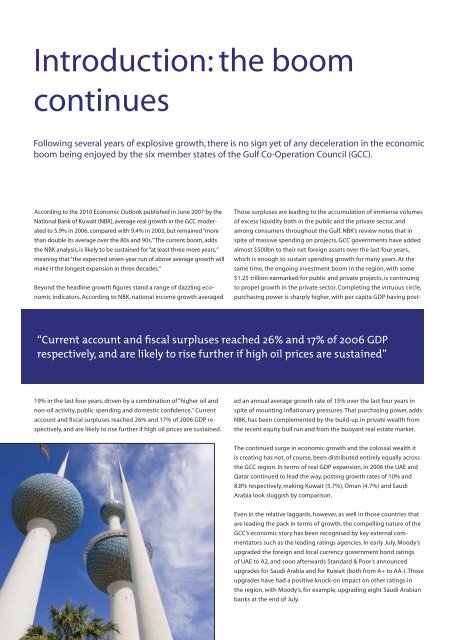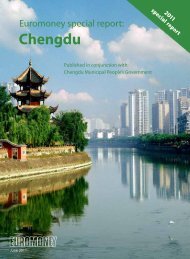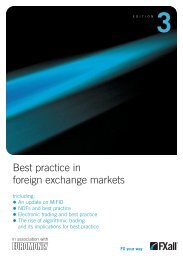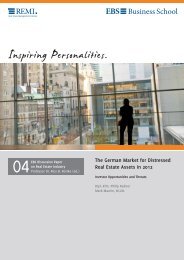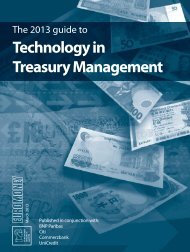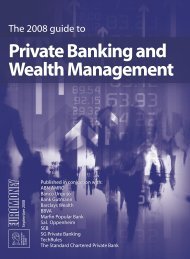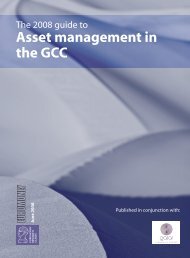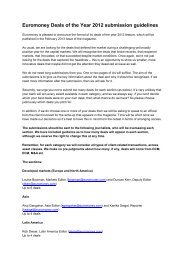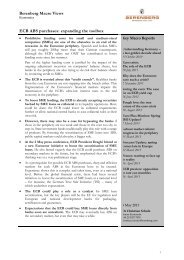Corporate Governance in the GCC - Euromoney
Corporate Governance in the GCC - Euromoney
Corporate Governance in the GCC - Euromoney
- No tags were found...
Create successful ePaper yourself
Turn your PDF publications into a flip-book with our unique Google optimized e-Paper software.
Introduction: <strong>the</strong> boomcont<strong>in</strong>uesFollow<strong>in</strong>g several years of explosive growth, <strong>the</strong>re is no sign yet of any deceleration <strong>in</strong> <strong>the</strong> economicboom be<strong>in</strong>g enjoyed by <strong>the</strong> six member states of <strong>the</strong> Gulf Co-Operation Council (<strong>GCC</strong>).Accord<strong>in</strong>g to <strong>the</strong> 2010 Economic Outlook published <strong>in</strong> June 2007 by <strong>the</strong>National Bank of Kuwait (NBK), average real growth <strong>in</strong> <strong>the</strong> <strong>GCC</strong> moderatedto 5.9% <strong>in</strong> 2006, compared with 9.4% <strong>in</strong> 2003, but rema<strong>in</strong>ed “morethan double its average over <strong>the</strong> 80s and 90s.” The current boom, adds<strong>the</strong> NBK analysis, is likely to be susta<strong>in</strong>ed for “at least three more years,”mean<strong>in</strong>g that “<strong>the</strong> expected seven-year run of above average growth willmake it <strong>the</strong> longest expansion <strong>in</strong> three decades.”Beyond <strong>the</strong> headl<strong>in</strong>e growth figures stand a range of dazzl<strong>in</strong>g economic<strong>in</strong>dicators. Accord<strong>in</strong>g to NBK, national <strong>in</strong>come growth averaged“Current account and fiscal surpluses reached 26% and 17% of 2006 GDPrespectively, and are likely to rise fur<strong>the</strong>r if high oil prices are susta<strong>in</strong>ed”19% <strong>in</strong> <strong>the</strong> last four years, driven by a comb<strong>in</strong>ation of “higher oil andnon-oil activity, public spend<strong>in</strong>g and domestic confidence.” Currentaccount and fiscal surpluses reached 26% and 17% of 2006 GDP respectively,and are likely to rise fur<strong>the</strong>r if high oil prices are susta<strong>in</strong>ed.Those surpluses are lead<strong>in</strong>g to <strong>the</strong> accumulation of immense volumesof excess liquidity both <strong>in</strong> <strong>the</strong> public and <strong>the</strong> private sector, andamong consumers throughout <strong>the</strong> Gulf. NBK’s review notes that <strong>in</strong>spite of massive spend<strong>in</strong>g on projects, <strong>GCC</strong> governments have addedalmost $500bn to <strong>the</strong>ir net foreign assets over <strong>the</strong> last four years,which is enough to susta<strong>in</strong> spend<strong>in</strong>g growth for many years. At <strong>the</strong>same time, <strong>the</strong> ongo<strong>in</strong>g <strong>in</strong>vestment boom <strong>in</strong> <strong>the</strong> region, with some$1.25 trillion earmarked for public and private projects, is cont<strong>in</strong>u<strong>in</strong>gto propel growth <strong>in</strong> <strong>the</strong> private sector. Complet<strong>in</strong>g <strong>the</strong> virtuous circle,purchas<strong>in</strong>g power is sharply higher, with per capita GDP hav<strong>in</strong>g postedan annual average growth rate of 15% over <strong>the</strong> last four years <strong>in</strong>spite of mount<strong>in</strong>g <strong>in</strong>flationary pressures. That purchas<strong>in</strong>g power, addsNBK, has been complemented by <strong>the</strong> build-up <strong>in</strong> private wealth from<strong>the</strong> recent equity bull run and from <strong>the</strong> buoyant real estate market.The cont<strong>in</strong>ued surge <strong>in</strong> economic growth and <strong>the</strong> colossal wealth itis creat<strong>in</strong>g has not, of course, been distributed entirely equally across<strong>the</strong> <strong>GCC</strong> region. In terms of real GDP expansion, <strong>in</strong> 2006 <strong>the</strong> UAE andQatar cont<strong>in</strong>ued to lead <strong>the</strong> way, post<strong>in</strong>g growth rates of 10% and8.8% respectively, mak<strong>in</strong>g Kuwait (5.7%), Oman (4.7%) and SaudiArabia look sluggish by comparison.Even <strong>in</strong> <strong>the</strong> relative laggards, however, as well <strong>in</strong> those countries thatare lead<strong>in</strong>g <strong>the</strong> pack <strong>in</strong> terms of growth, <strong>the</strong> compell<strong>in</strong>g nature of <strong>the</strong><strong>GCC</strong>’s economic story has been recognised by key external commentatorssuch as <strong>the</strong> lead<strong>in</strong>g rat<strong>in</strong>gs agencies. In early July, Moody’supgraded <strong>the</strong> foreign and local currency government bond rat<strong>in</strong>gsof UAE to A2, and soon afterwards Standard & Poor’s announcedupgrades for Saudi Arabia and for Kuwait (both from A+ to AA-). Thoseupgrades have had a positive knock-on impact on o<strong>the</strong>r rat<strong>in</strong>gs <strong>in</strong><strong>the</strong> region, with Moody’s, for example, upgrad<strong>in</strong>g eight Saudi Arabianbanks at <strong>the</strong> end of July.


